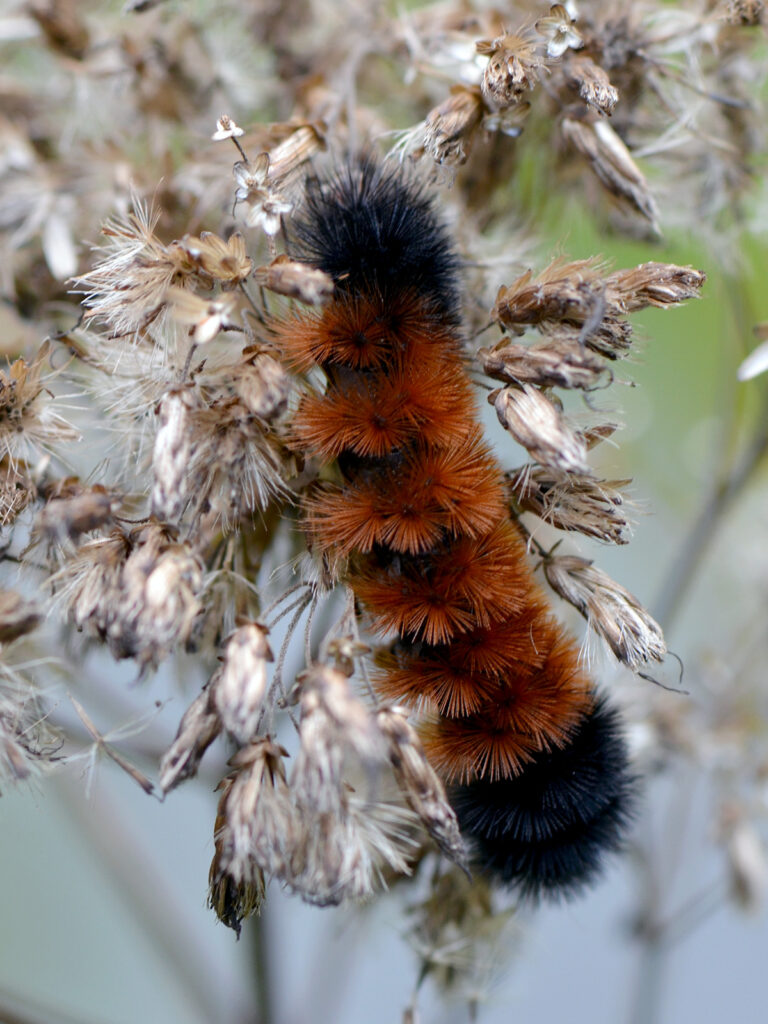
Below are the species of butterflies, moths, and skippers we’ve found in our yard over the years.
I suspect that we haven’t seen many of the moths that visit our habitat garden, since most of them are nocturnal.
We do frequently see the wooly bear caterpillar, which becomes the isabella tiger moth.
I list the butterflies on these pages in the order that the Stokes Butterfly book arranges them: Swallowtails, Whites and Sulphurs, Gossamer Wings [Hairstreaks and Blues], Brush-footed [Varied Brushfoots (Anglewings and Painted Ladies), Fritillaries, Crescents and Checkerspots, Admirals], and Milkweed butterflies
Butterflies we’ve seen in our yard
- Pipevine swallowtail (Battus philenor)
- Black swallowtail (Papilio polyxenes)
- Giant swallowtail (Papilio cresphontes)
- Eastern tiger swallowtail (Papilio glaucus)
- Spicebush swallowtail (Papilio troilus)
- Clouded sulphur (Colias philodice)
- Banded hairstreak (Satyrium calanus)
- Spring azure (Celastrina ladon)
- Eastern tailed blue (Everes comyntas)
- Question mark (Polygonia interrogationis)
- Comma (Polygonia comma)
- Mourning cloak (Nymphalis antiopa)
- Red admiral (Vanessa atalanta)
- American lady (Vanessa virginiensis)
- Painted lady (Vanessa cardui)
- Great spangled fritillary (Speyeria cybele)
- Baltimore checkerspot (Euphydryas phaeton)
- Pearl crescent (Phyciodes tharos)
- Northern crescent (Phyciodes cocyta)
- Red-spotted purple (Limenitis arthemis)
- White admiral (Limenitis arthemis)
- Viceroy (Limenitis archippus)
- Monarch (Danaus plexippus) (more on monarchs)
Moths we’ve seen in our yard
- Hummingbird moth (Hemaris thysbe)
- Nessus sphinx moth (Amphion floridensis)
- Squash vine borer moth (Melittia cucurbitae)
- Snowberry clearwing (Hemaris diffinis)
- Eight-spotted forester (Alypia octomaculata)
- Darling underwing moth (Catocala cara)
- Raspberry pyrausta (Pyrausta signatalis)
- Orange mint moth (Pyrausta orphisalis)
- Yellow-collared scape moth (Cisseps fulvicollis)
- Lesser maple spanworm moth (Macaria pustularia)
- Goldenrod borer plume moth (Hellinsia kellicottii)
- Confused haploa (Haploa confusa)
- Tebenna (T. onustana) or (T. gnaphaliella)
- Polyphemus silk moth (Anteraea polyphemus)
- Common looper moth (Autographa precationis)
- Armyworm moth (Mythimna unipuncta)
- Isabella tiger moth (Pyrrharctic isabella)
- White-marked tussock moth (Orgyia leucostigma)
- Giant leopard moth (Hypercompe scribonia)
- Curved-tooth geometer (Eutrapela clemataria)
- Goldenrod hooded owlet (Cucullia asteroides)
- Patalene (Patalene spp)
Skippers we’ve seen in our yard
- European skipper (?) (Thymelicus lineola)
- Silver-spotted skipper (Epargyreus clarus)
- Dreamy duskywing (Erynnis icelus)
- Columbine duskywing (Erynnis lucilius)
- Horace’s duskywing (Erynnis horatius)
- Wild indigo duskywing (Erynnis baptisiae)
Resources
- BAMONA:
- Butterflies and Moths of North America: Collecting and sharing data about Lepidoptera
- Iowa State Univ:
- For bug identification: BugGuide.net – a remarkable website with a host of volunteers to help identify all kinds of “bugs.”
- Maine Cooperative Extension:
- MPG:
- Moth Photographers Group – includes photos of caterpillars, which is handy to have
Reflections
Diversity of species is a form of safety in numbers — not numbers of individuals, but numbers of ways in which each individual’s prodigious reproductive power is modulated by conflicts of interest among all the individuals with which it shares the land. The more species there are, the less likely it is that any one of them will get out of hand and — just as true — the less likely that any one of them will suffer unduly.
~ Sara Stein, Noah’s Garden: Restoring the Ecology of Our Own Back Yards, 1993, p. 13
